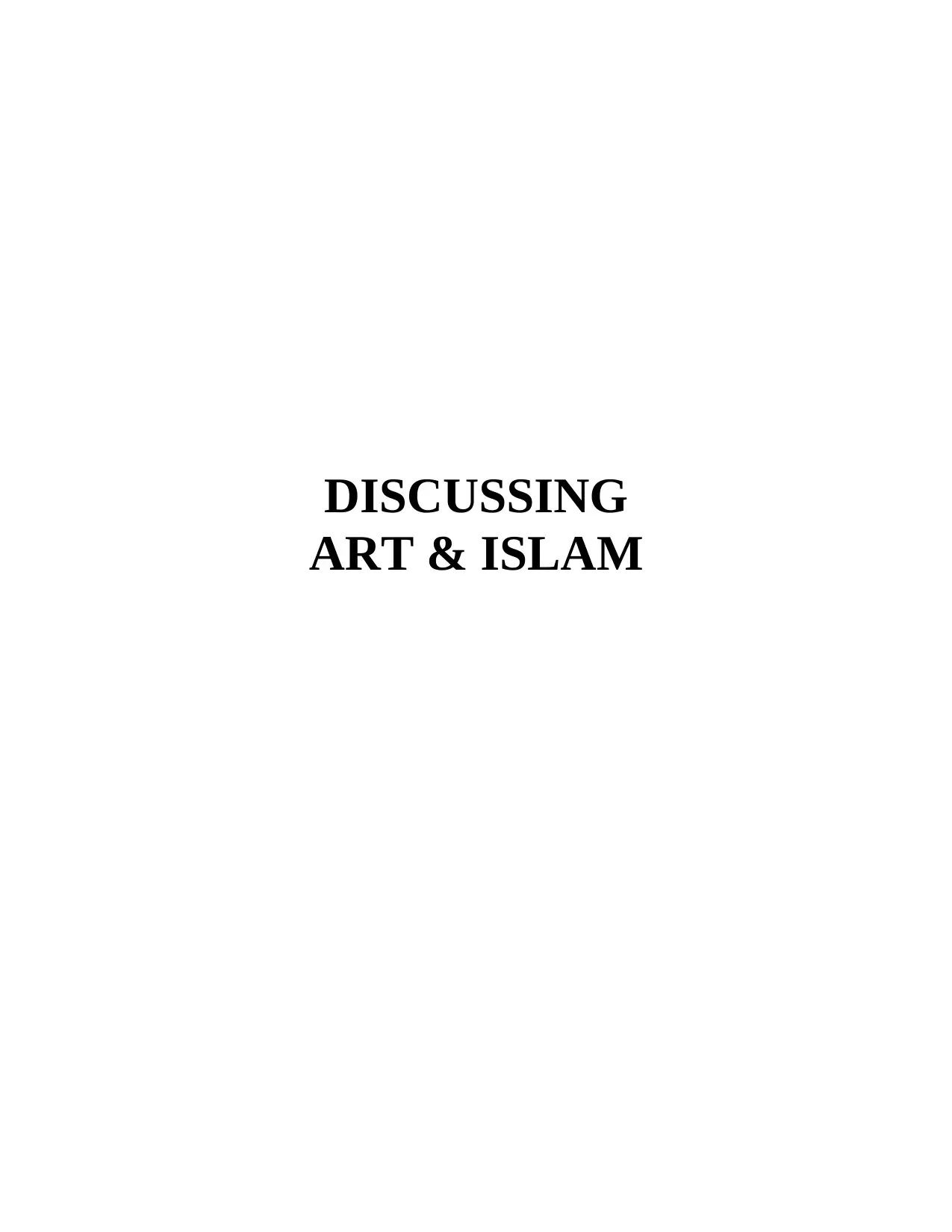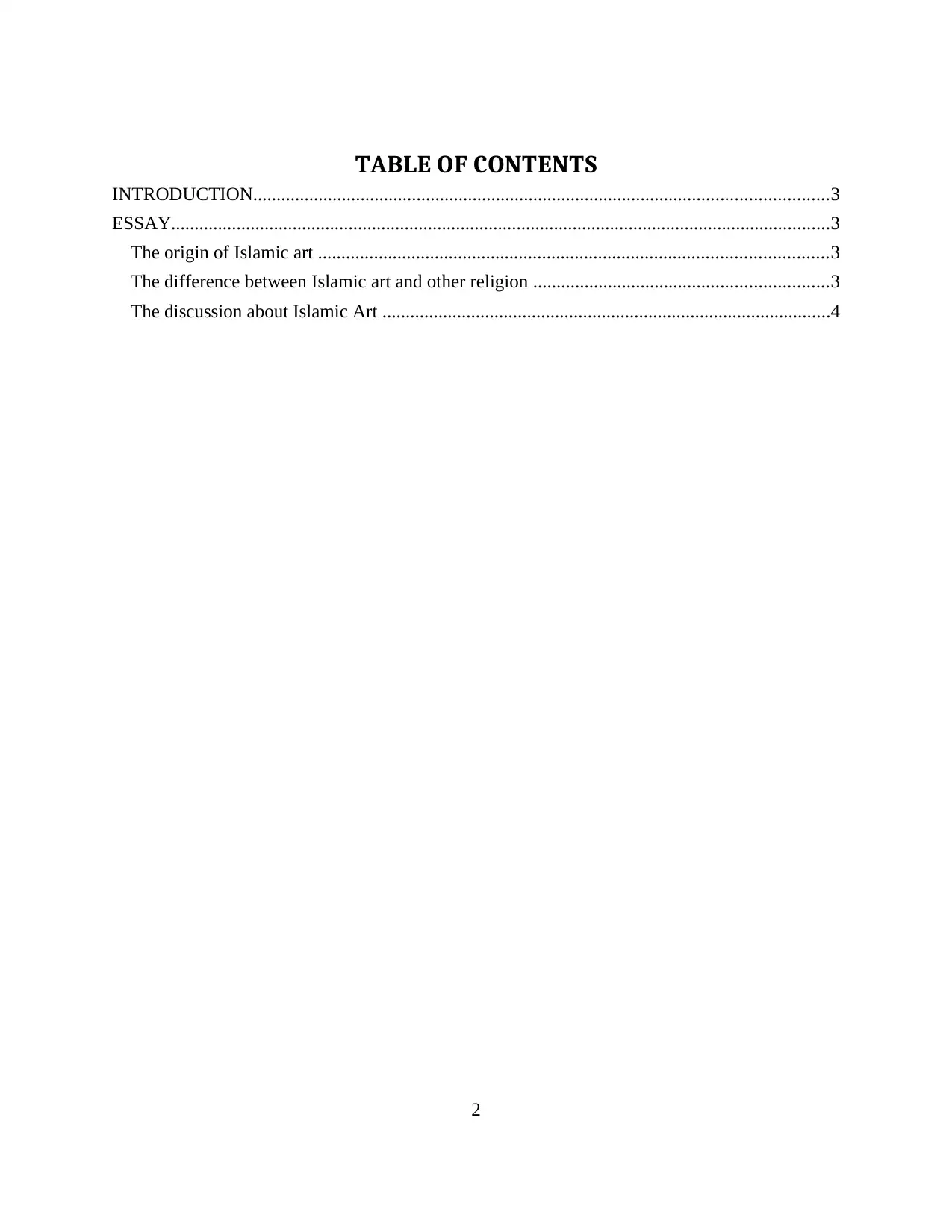Art & Islam Report
VerifiedAdded on 2020/02/05
|5
|802
|267
Report
AI Summary
This report delves into the multifaceted world of Islamic art, tracing its origins from the 7th century and highlighting its unique characteristics. It differentiates Islamic art from other religious art forms, emphasizing its broader scope encompassing various artistic expressions beyond religious iconography. The report showcases examples of Islamic art's influence on architecture, calligraphy, and decorative arts, citing renowned structures like the Taj Mahal and the Great Mosque of Xian. It concludes by underscoring the significant contributions of various empires, including the Ottomans, Mughals, Safavids, and Qajars, in promoting and shaping Islamic art's distinctive identity.

DISCUSSING
ART & ISLAM
ART & ISLAM
Paraphrase This Document
Need a fresh take? Get an instant paraphrase of this document with our AI Paraphraser

TABLE OF CONTENTS
INTRODUCTION...........................................................................................................................3
ESSAY.............................................................................................................................................3
The origin of Islamic art .............................................................................................................3
The difference between Islamic art and other religion ...............................................................3
The discussion about Islamic Art ................................................................................................4
2
INTRODUCTION...........................................................................................................................3
ESSAY.............................................................................................................................................3
The origin of Islamic art .............................................................................................................3
The difference between Islamic art and other religion ...............................................................3
The discussion about Islamic Art ................................................................................................4
2

INTRODUCTION
Islamic art is refereed as most vibrant, distinguishing and effective conception. It was
further developed by the art historians in the 19th century. The concept of Islamic art does not
only represent the art developed particularly in the service of the Muslim trust but also features
the architecture and creativity emerged historically in the lands ruled by Muslims, developed by
Muslim patriots or artist (Beblawi and Luciani, 2015). Therefore, Islamic art is way beyond the
religious art. It further tends to showcase the significance and essence of belongings instead of
just their physical form. The Islam use calligraphy language which is another type of art.
Therefore, it can be stated that, Islam supported the belief of developing a distinctive culture
which have is own unique language that also showcase the art and architecture throughout the
Muslim world. In this report, various aspects related to art and Islam will be discussed.
ESSAY
The origin of Islamic art
The Islamic art refers to visual arts, developed by Muslims and non- Muslim artist within
the dominion possessed by the individuals and cultures of Islam. The Islamic art spans 1400
years of history and also possess fabulous geographic diversity. Therefore, the Islamic art
started developing from the 7th century onward (Introduction of Islamic Art, 2016). The Islamic
art can be stated as umbrella term that pertains to contrasting art forms like, architecture,
decoration, pottery, paintings, drawings, embroidery, wood carving, gemstone carving,
calligraphy, metalworking, sculptures etc. The Islamic art is further based on contrasting styles,
techniques and forms showcasing the mix of classical and Iranian architectural themes and
designs. Also, the different mosque located in different par of the world are fine example of
vibrant art and architecture (Jamal, 2014).
The difference between Islamic art and other religion
The Islamic art is quiet different from the artistry in other religion. Such as, famous
Christian, Jewish and Buddhism art is based on the religious belief. There art describes the
message of their religion, the sculptures are based on their god and goddess etc. On the contrast,
Islamic art refers to all kind of art forms originated in the Islamic world (Islamic Art, 2016).
3
Islamic art is refereed as most vibrant, distinguishing and effective conception. It was
further developed by the art historians in the 19th century. The concept of Islamic art does not
only represent the art developed particularly in the service of the Muslim trust but also features
the architecture and creativity emerged historically in the lands ruled by Muslims, developed by
Muslim patriots or artist (Beblawi and Luciani, 2015). Therefore, Islamic art is way beyond the
religious art. It further tends to showcase the significance and essence of belongings instead of
just their physical form. The Islam use calligraphy language which is another type of art.
Therefore, it can be stated that, Islam supported the belief of developing a distinctive culture
which have is own unique language that also showcase the art and architecture throughout the
Muslim world. In this report, various aspects related to art and Islam will be discussed.
ESSAY
The origin of Islamic art
The Islamic art refers to visual arts, developed by Muslims and non- Muslim artist within
the dominion possessed by the individuals and cultures of Islam. The Islamic art spans 1400
years of history and also possess fabulous geographic diversity. Therefore, the Islamic art
started developing from the 7th century onward (Introduction of Islamic Art, 2016). The Islamic
art can be stated as umbrella term that pertains to contrasting art forms like, architecture,
decoration, pottery, paintings, drawings, embroidery, wood carving, gemstone carving,
calligraphy, metalworking, sculptures etc. The Islamic art is further based on contrasting styles,
techniques and forms showcasing the mix of classical and Iranian architectural themes and
designs. Also, the different mosque located in different par of the world are fine example of
vibrant art and architecture (Jamal, 2014).
The difference between Islamic art and other religion
The Islamic art is quiet different from the artistry in other religion. Such as, famous
Christian, Jewish and Buddhism art is based on the religious belief. There art describes the
message of their religion, the sculptures are based on their god and goddess etc. On the contrast,
Islamic art refers to all kind of art forms originated in the Islamic world (Islamic Art, 2016).
3
⊘ This is a preview!⊘
Do you want full access?
Subscribe today to unlock all pages.

Trusted by 1+ million students worldwide

The discussion about Islamic Art
The Islamic art can be witnessed at present in the beauty of various buildings, paintings,
rugs and carpets, ivory carving etc (Comtet, 2012). The famous Tajmahal a monument listed in
Seven Wonders is a example of Islamic Art. The Great mosque of Xian, in China also represent
great architect as it is designed like contemporary Buddhist temple. Thereafter, the Al-azhar
mosque of Egypt also recognized for its architectural and cultural history. The art in Islam
emphasis that any image or figure can be included into the universe of Islam only if it is confined
to its limits and does not involve directly in the spiritual economy of Islam. Further, art in Islam
is inspired and integrated from traditions of Arab, Perisian and Turkish (Adahl, 2013).
CONCLUSION
From the above report, it can be concluded that art and architecture are integral part of
Islam. The Islamic art was promoted maximum in three empires, ottomans, mughals and Safavid
and Qajars. The Islamic art further provide distinctiveness to the Islam religion as compared to
others.
4
The Islamic art can be witnessed at present in the beauty of various buildings, paintings,
rugs and carpets, ivory carving etc (Comtet, 2012). The famous Tajmahal a monument listed in
Seven Wonders is a example of Islamic Art. The Great mosque of Xian, in China also represent
great architect as it is designed like contemporary Buddhist temple. Thereafter, the Al-azhar
mosque of Egypt also recognized for its architectural and cultural history. The art in Islam
emphasis that any image or figure can be included into the universe of Islam only if it is confined
to its limits and does not involve directly in the spiritual economy of Islam. Further, art in Islam
is inspired and integrated from traditions of Arab, Perisian and Turkish (Adahl, 2013).
CONCLUSION
From the above report, it can be concluded that art and architecture are integral part of
Islam. The Islamic art was promoted maximum in three empires, ottomans, mughals and Safavid
and Qajars. The Islamic art further provide distinctiveness to the Islam religion as compared to
others.
4
Paraphrase This Document
Need a fresh take? Get an instant paraphrase of this document with our AI Paraphraser

REFERENCES
Books and Journal
Adahl, K., 2013. Islamic art collections: an international survey. Routledge.
Beblawi, H. and Luciani, G. eds., 2015. The Rentier State. Routledge.
Comtet, L., 2012. Advanced Combinatorics: The art of finite and infinite expansions. Springer
Science & Business Media.
Jamal, A., 2014. Islam and the Politics of Culture in Europe: Memory, Aesthetics, Art. Journal
of Contemporary European Studies. 22(4). pp.541-543.
Online
Introduction of Islamic Art. 2016. [Online]. Available through:
<http://www.bbc.co.uk/religion/religions/islam/art/art_1.shtml>. [Accessed on 13th
June 2016].
Islamic Art. 2016. [Online]. Available through: <http://www.visual-arts-cork.com/islamic-
art.htm>. [Accessed on 13th June 2016].
5
Books and Journal
Adahl, K., 2013. Islamic art collections: an international survey. Routledge.
Beblawi, H. and Luciani, G. eds., 2015. The Rentier State. Routledge.
Comtet, L., 2012. Advanced Combinatorics: The art of finite and infinite expansions. Springer
Science & Business Media.
Jamal, A., 2014. Islam and the Politics of Culture in Europe: Memory, Aesthetics, Art. Journal
of Contemporary European Studies. 22(4). pp.541-543.
Online
Introduction of Islamic Art. 2016. [Online]. Available through:
<http://www.bbc.co.uk/religion/religions/islam/art/art_1.shtml>. [Accessed on 13th
June 2016].
Islamic Art. 2016. [Online]. Available through: <http://www.visual-arts-cork.com/islamic-
art.htm>. [Accessed on 13th June 2016].
5
1 out of 5
Related Documents
Your All-in-One AI-Powered Toolkit for Academic Success.
+13062052269
info@desklib.com
Available 24*7 on WhatsApp / Email
![[object Object]](/_next/static/media/star-bottom.7253800d.svg)
Unlock your academic potential
Copyright © 2020–2025 A2Z Services. All Rights Reserved. Developed and managed by ZUCOL.

![Art History: Comparing Greek and Roman Art, [University Name]](/_next/image/?url=https%3A%2F%2Fdesklib.com%2Fmedia%2Fimages%2Fxg%2F6bc872f5e2ed4cb793eeeb5c835ed261.jpg&w=256&q=75)

